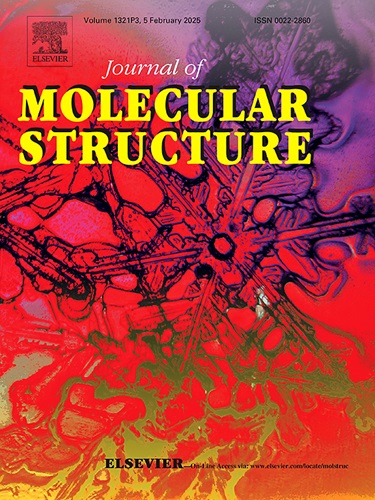紫杉树衍生碳点:Fe +和Cu +选择性鉴定的设计、合成和荧光传感能力
IF 4
2区 化学
Q2 CHEMISTRY, PHYSICAL
引用次数: 0
摘要
采用煅烧法合成了芫荽籽衍生碳点(Sc@CQDs)。Sc@CQDs具有优异的光学性能,包括高量子产率(52.8%)和高荧光性质。利用HRTEM、XPS、XRD、NMR、FTIR、UV可见光谱等先进技术对Sc@CQDs进行了结构分析。HRTEM数据证实了Sc@CQDs的球形形貌,平均尺寸为3.6 nm。Sc@CQDs对Fe + /Cu2+离子的检测灵敏度较高,检测限(LOD)分别为0.18µM和0.11µM。寿命衰减分析证实了静态猝灭机制,Sc@CQDs、Sc@CQDs + Fe3+和Sc@CQDs + Cu2+的荧光寿命分别为2.57 ns、2.68 ns和2.69 ns。该研究突出了Sc@CQDs在环境监测和需要检测Fe³+ /Cu2+离子的工业过程中的环保合成和实际应用。此外,所开发的传感器具有更高的检测实际水样中Fe + /Cu2+离子的潜力,且回收率高。本文章由计算机程序翻译,如有差异,请以英文原文为准。

Syzygium cumini derived carbon dot: Design, synthesis and fluorescent sensing abilities towards selective identification of Fe³⁺ and Cu²⁺ ions
Syzygium cumini seeds derived Carbon dots (Sc@CQDs) have been synthesized by using calcination method. The Sc@CQDs exhibits remarkable optical properties, including high quantum yield (52.8 %) and highly fluorescent in nature. The structural analysis of developed Sc@CQDs has been done by various advance technique such as HRTEM, XPS, XRD, NMR, FTIR and UV visible spectroscopy. The HRTEM data confirmed the spherical morphology of Sc@CQDs with average size 3.6 nm. The Sc@CQDs demonstrate sensitive detection of Fe³⁺/Cu2+ ions with limit of detection (LOD) of 0.18 µM and 0.11 µM. The life time decay analysis confirmed the static quenching mechanism having the fluorescence lifetime for Sc@CQDs, Sc@CQDs + Fe3+ and Sc@CQDs + Cu2+were 2.57 ns, 2.68 ns and 2.69 ns respectively This study highlights the eco-friendly synthesis and practical application of Sc@CQDs in environmental monitoring and industrial processes requiring Fe³⁺/Cu2+ ions detection. Further, the developed sensor possessed higher potential for the detection of Fe³⁺/Cu2+ ions in real water samples with superior recovery rate.
求助全文
通过发布文献求助,成功后即可免费获取论文全文。
去求助
来源期刊

Journal of Molecular Structure
化学-物理化学
CiteScore
7.10
自引率
15.80%
发文量
2384
审稿时长
45 days
期刊介绍:
The Journal of Molecular Structure is dedicated to the publication of full-length articles and review papers, providing important new structural information on all types of chemical species including:
• Stable and unstable molecules in all types of environments (vapour, molecular beam, liquid, solution, liquid crystal, solid state, matrix-isolated, surface-absorbed etc.)
• Chemical intermediates
• Molecules in excited states
• Biological molecules
• Polymers.
The methods used may include any combination of spectroscopic and non-spectroscopic techniques, for example:
• Infrared spectroscopy (mid, far, near)
• Raman spectroscopy and non-linear Raman methods (CARS, etc.)
• Electronic absorption spectroscopy
• Optical rotatory dispersion and circular dichroism
• Fluorescence and phosphorescence techniques
• Electron spectroscopies (PES, XPS), EXAFS, etc.
• Microwave spectroscopy
• Electron diffraction
• NMR and ESR spectroscopies
• Mössbauer spectroscopy
• X-ray crystallography
• Charge Density Analyses
• Computational Studies (supplementing experimental methods)
We encourage publications combining theoretical and experimental approaches. The structural insights gained by the studies should be correlated with the properties, activity and/ or reactivity of the molecule under investigation and the relevance of this molecule and its implications should be discussed.
 求助内容:
求助内容: 应助结果提醒方式:
应助结果提醒方式:


